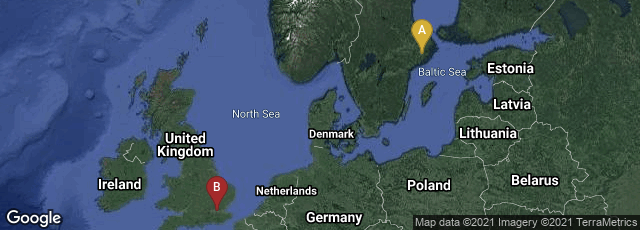
A: Norrmalm, Stockholm, Stockholms län, Sweden, B: London, England, United Kingdom
In 1843 Swedish authors and inventors Georg and Evard Scheutz, inspired by Dionysius Lardner’s account of Babbage’s Difference Engine, working in Stockholm, constructed the first working difference engine based on Babbage's design. One of the reasons the Scheutzs were able to build the engine, while Babbage could not, was that they were willing to machine the parts to lower tolerances than Babbage demanded, with the result that the Scheutz machine was prone to errors.
In 1849 Georg Scheutz published in Stockholm Nytt och enkelt sätt att lösa nummereqvationer af hogre och lägre grader efter Agardhska teorien: För praktiska behov [A new and simple method of solving numerical equations of higher and lower degree with the help of Agardh’s theory: For practical purposes]. and Bihang till skriften: Nytt och enkelt sätt att lösa nummereqvationer af hogre och lägre grader efter Agardhska teorien. Innehällande seriemetodens tillämpning vid bestämmandet af imaginära, lika, och nära hvarandra belägna rötter i en eqvation. Af C[arl] A[dolph] Agardh [1785-1859] . . . Utgifvet af Georg Scheutz [Appendix to the treatise: A new and simple method of solving numerical equations, using Agardh’s theory, containing the serial method used in determining imaginary, exact, and approximate roots of an equation. By C. A. Agardh, . . . edited by G. S.].
The Scheutz machine, of which three examples were built, was based upon Charles Babbage’s design for his famous Difference Engine No. 1, which Babbage worked on intermittently between 1822 and 1834 before abandoning the project uncompleted (only a small working portion, about one-ninth the size of the projected Difference Engine, was ever constructed; the uncompleted machine ended up costing the British Government over £17,000).
Georg Scheutz—described by Lindgren as an “auditor, printer, journalist and editor, political commentator, spokesman for technology, translator and inventor”—first learned of Babbage’s Difference Engine circa 1830. Although his imagination was immediately fired by the possibilities of such a machine, he was unable to begin designing his own version until 1834, when Dionysius Lardner published his detailed review of Babbage’s Difference Engine in the July issue of the Edinburgh Review. Drawing on the information in Lardner’s article, Scheutz and his teenage son Edvard began working on their own design for a difference engine, which was both simpler and cheaper to produce than Babbage’s machine.
The Scheutz difference engine no. 1, a prototype model built by Edvard, was completed in 1843 and certified by members of the Swedish Academy of Sciences. Despite this mark of favor, the Scheutzes were initially unable to stir up any interest or official support for their machine, either at home or abroad. They did no further work on the Scheutz machine until 1850, when, in response to renewed interest in machines for printing tables, they began working on the Scheutz difference engine no. 2.
However, the Scheutz machine no. 1 did not lie entirely fallow during the seven years between 1843 and 1850, for in 1849, Georg Scheutz used it to produce and print a table of a polynomial of the third degree, which he published in Nytt och enkelt sätt att lösa nummereqvationer af hogre och lägre grader efter Agardhska teorien. This little one-column table, found on p. 74 of Scheutz’s pamphlet, is the earliest known automatically produced numerical table.
"In [Scheutz’s Nytt och enkelt sätt att lösa nummereqvationer af hogre och lägre grader efter Agardhska teorien] he gave an exposition of the method of solving equations by the method of differences, which the professor of botany, mathematician and latterly bishop Carl Adolph Agardh had presented in 1809. In an addendum he remarks that while the method is excellent, it is time consuming when used on equations of high degree. He then adds that this disadvantage could be removed if one 'could assign the laborious and time consuming figure work to some assistant, that never tired, never made an error and dealt with the numerical calculations for the higher degrees as swiftly and certainly as those for the first degree.” Georg Scheutz notes that such an assistant does in fact exist and he gives an example of a stereotyped table calculated and printed by the first engine. . . . The table shows that Scheutz still was fascinated by the machine’s capability to solve equations. But more importantly, this table is the only existing illustration [emphasis ours] of what the Scheutz prototype engine could do. It is also the oldest automatically made numerical table in the world, which has been preserved " (Lindgren, Glory and Failure: The Difference Engines of Johann Müller, Charles Babbage and Georg and Edvard Scheutz [1987] 138-39).
Lindgren was the first to note the existence of this numerical table generated by the Scheutz difference engine no. 1. Prior to this, the first examples of tables produced by a Scheutz engine were thought to have been contained in the Scheutz’s Specimens of Tables, Calculated, Stereomoulded and Printed by Machinery (London, 1857), which the Scheutzes produced, probably with Charles Babbage's cooperation, in both English and French editions as a means of showcasing the improved Scheutz difference engine no. 2, which was produced by the brothers in 1853.
The standard histories of computing, including Aspray’s Computing before Computers (1990), contain no reference to the table printed by the Scheutz difference engine no. 1.
Merzbach, Georg Scheutz and the First Printing Calculator (1977).